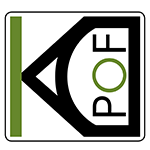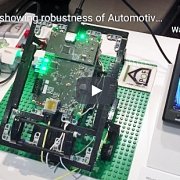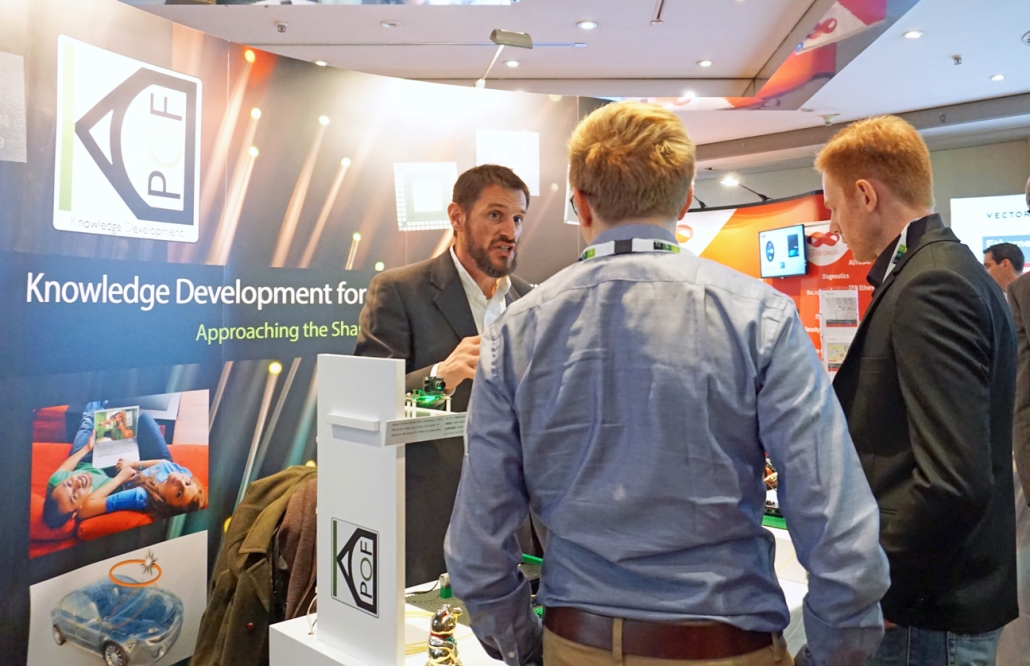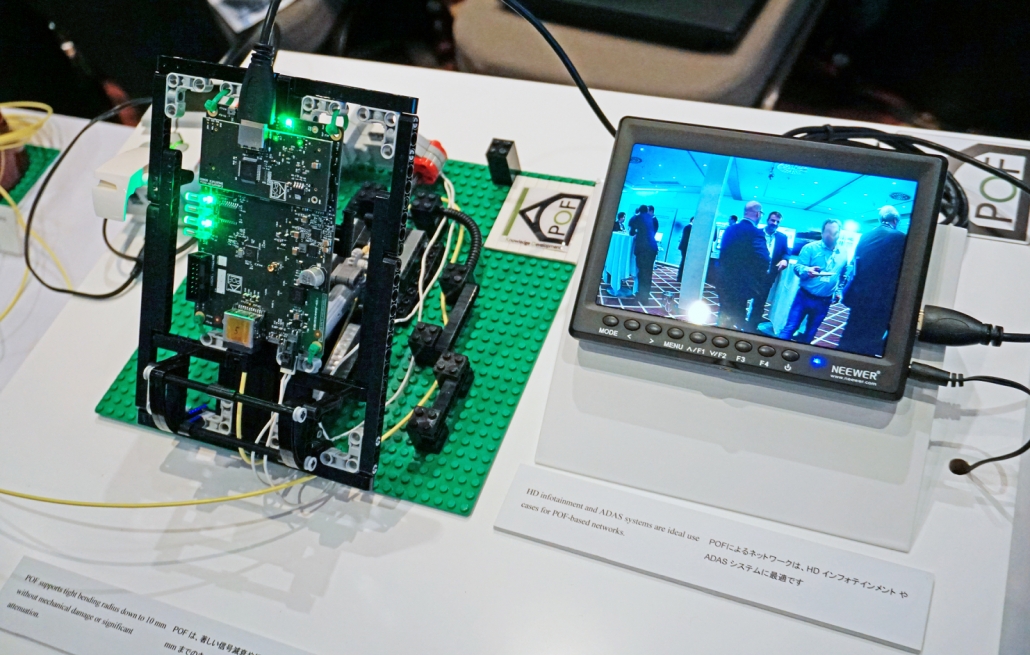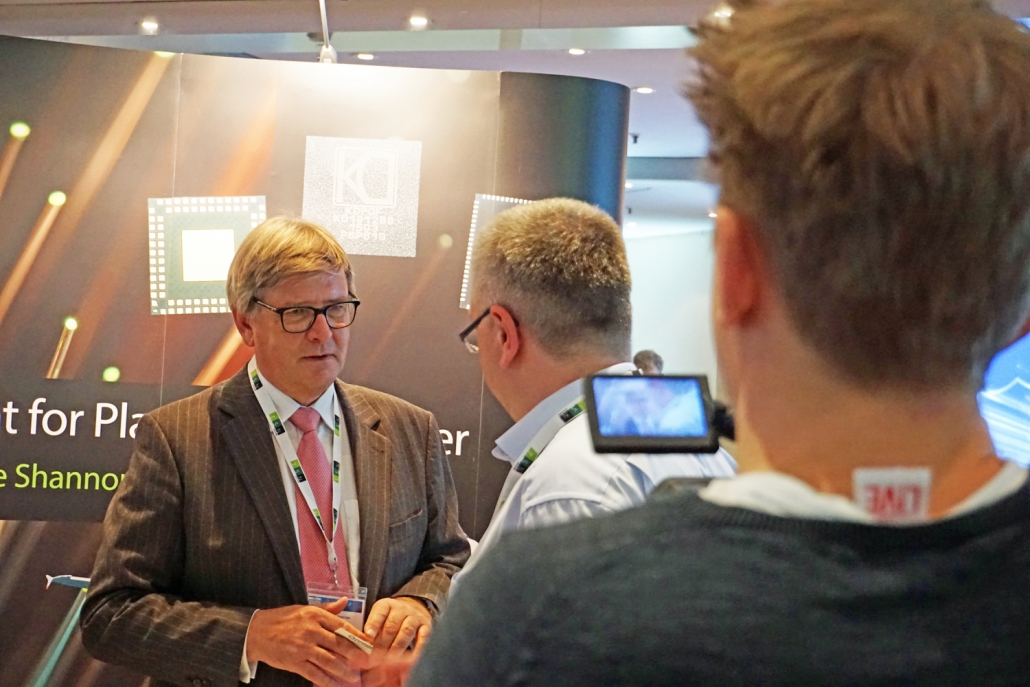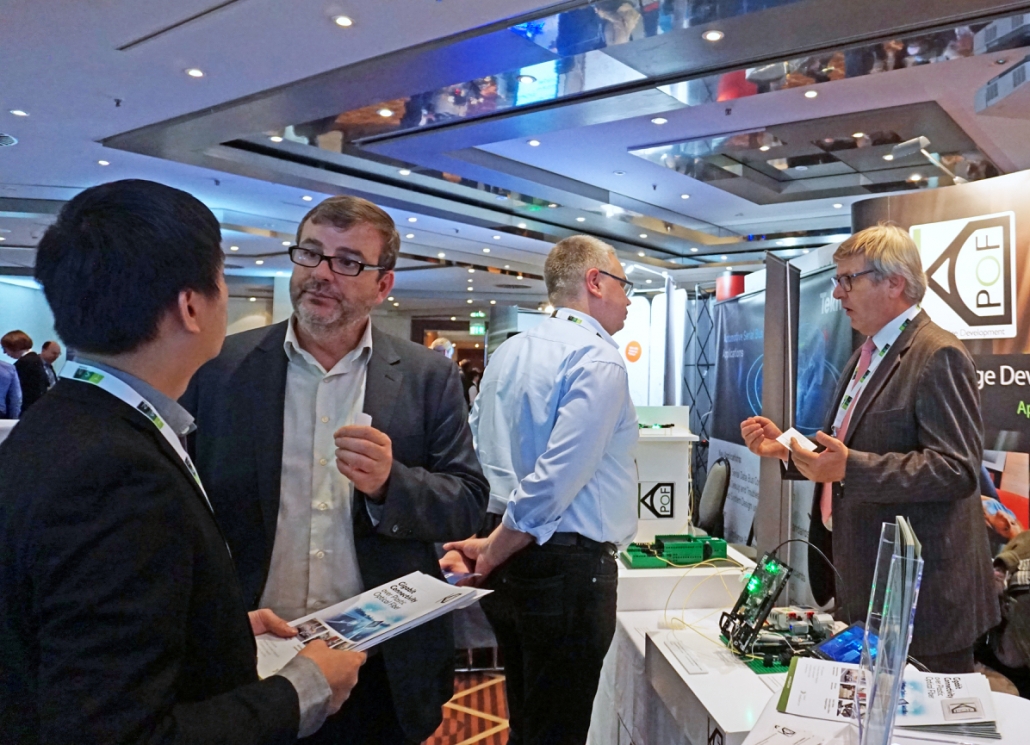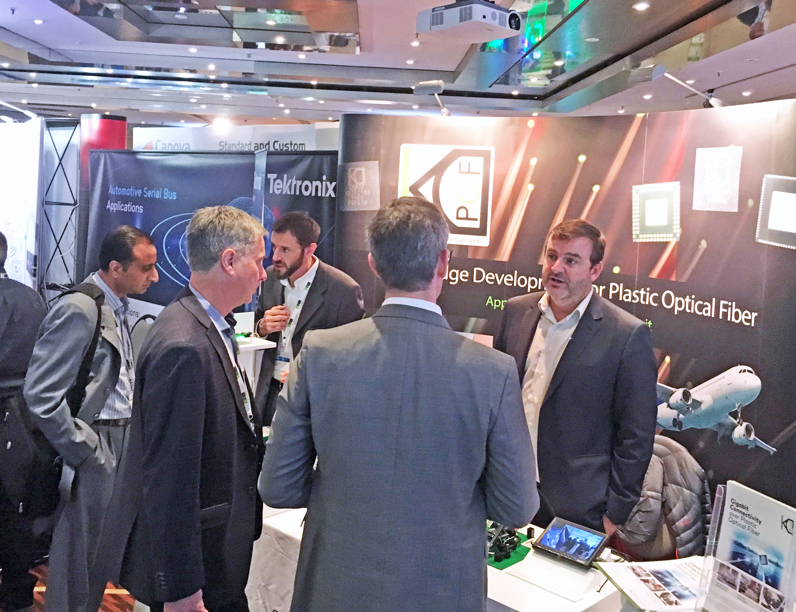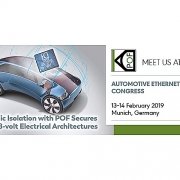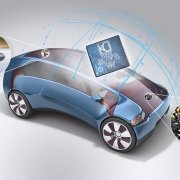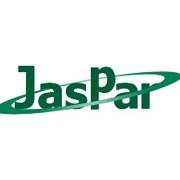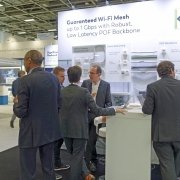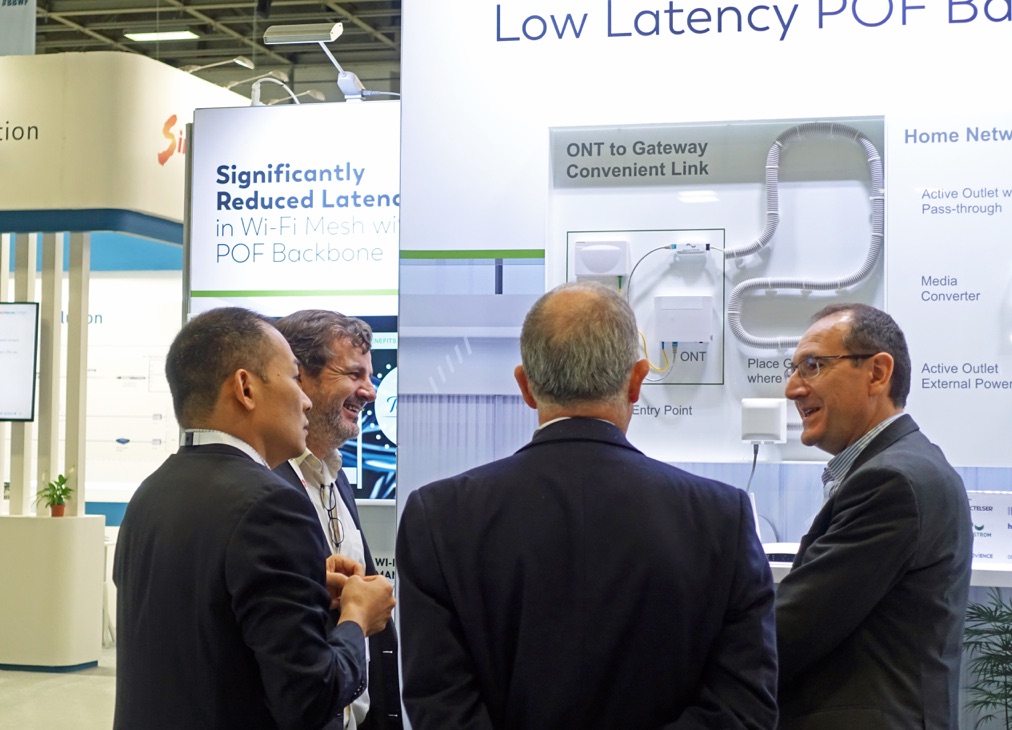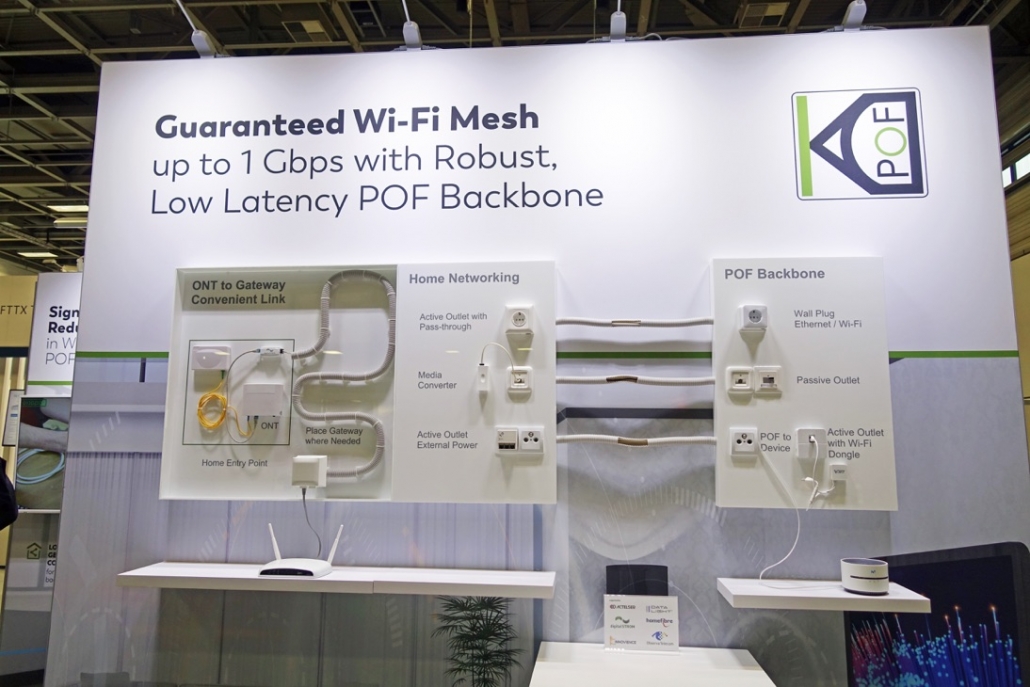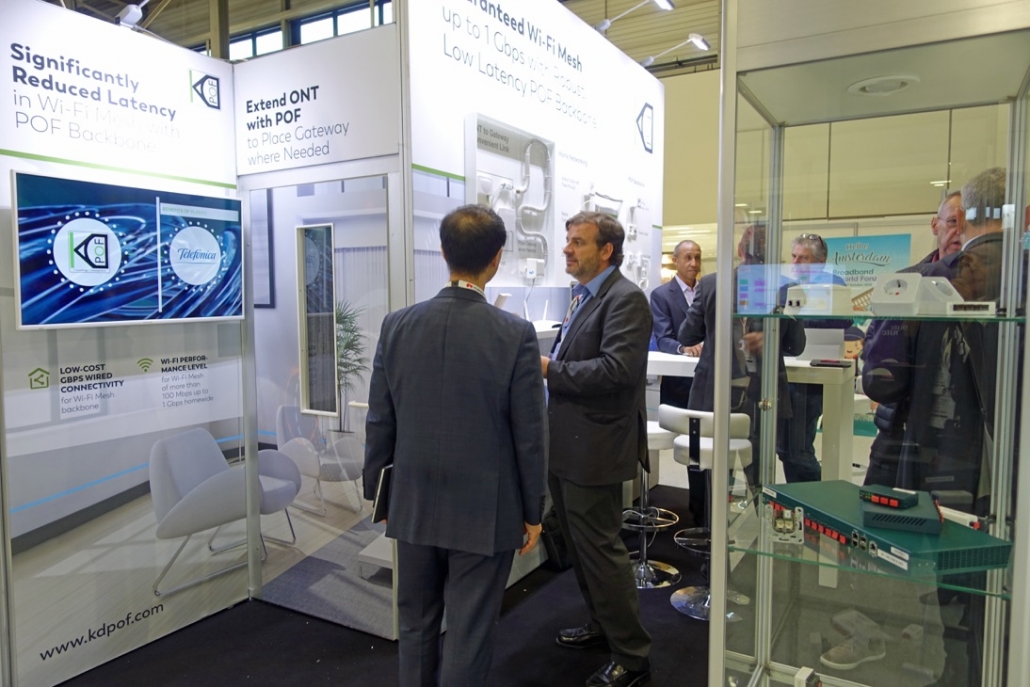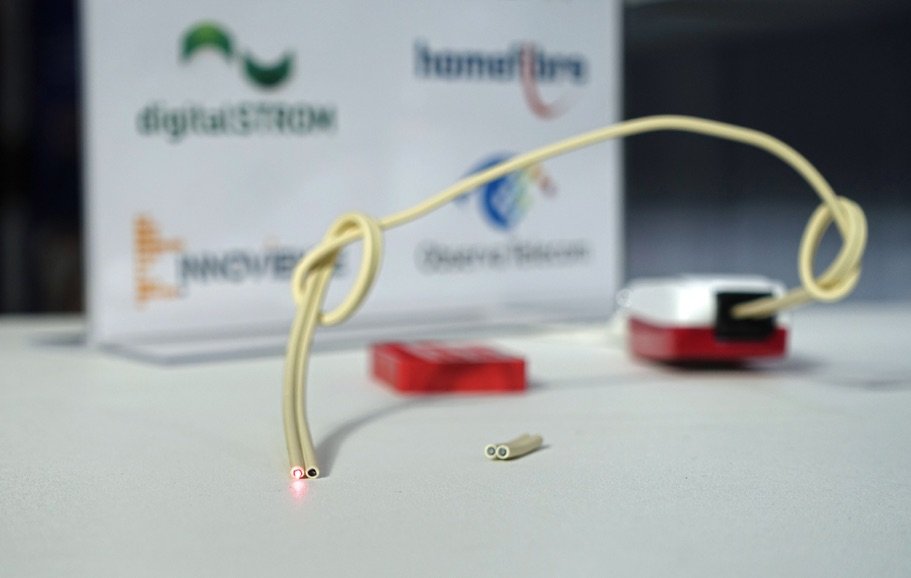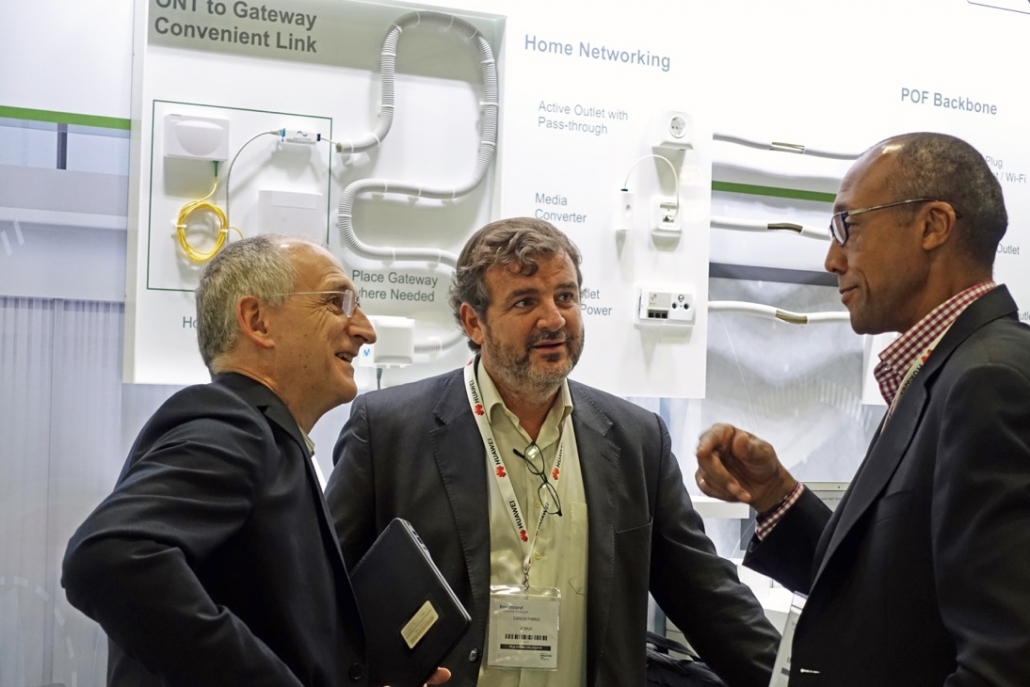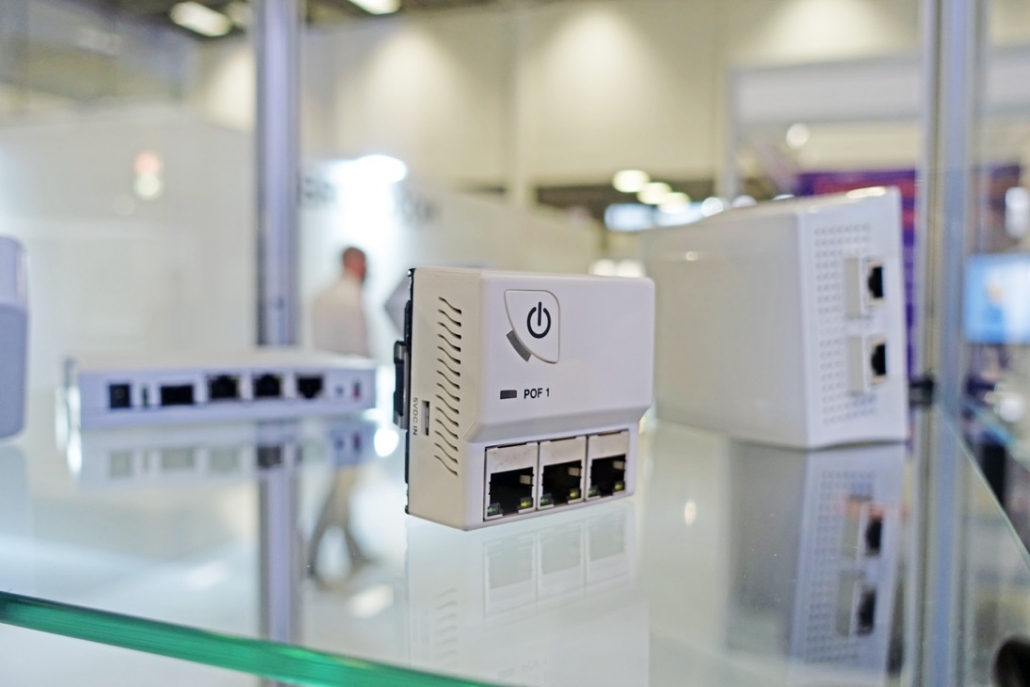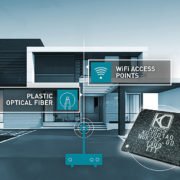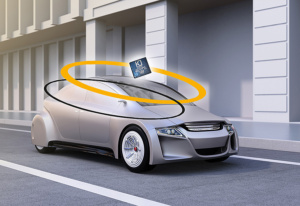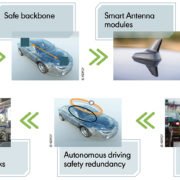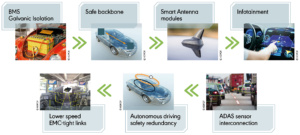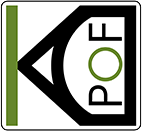At the recent Automotive Ethernet Congress in Munich, Germany, KDPOF presented the innovative Automotive Gigabit Ethernet Plastic Optical Fiber (GEPOF). “We are delighted by the great interested we received for our POF technology that secures new 48-volt electrical architectures via the inherent galvanic isolation,” stated Carlos Pardo, CEO and Co-founder of KDPOF. Optical connections with POF provide the optimal network to achieve galvanic isolation, providing 100 Mbps and 1 Gbps Ethernet compatible solutions with enough margin to withstand the harsh automotive environment. Applications such as Battery Management Systems (BMS) and Integrated Smart Antenna (ISA) modules profit from the inherent Electromagnetic Compatibility (EMC) of POF.
KDPOF – leading supplier for gigabit transceivers over POF (Plastic Optical Fiber) – will present automotive Gigabit Ethernet POF (GEPOF) for future wire harness architectures at stand 18 at the 7th International Conference Automotive Wire Harness on March 26 and 27, 2019 in Ludwigsburg, Germany. “With its inherent galvanic isolation and robustness, the optical Ethernet technology ideally suits current and future in-vehicle network infrastructure,” stated Carlos Pardo, CEO and Co-founder of KDPOF. “POF lives up to the challenges of electromagnetic compatibility and safety requirements created by the new 48-volt electrical architecture.” A well-supplied and competitive market worldwide ensures seamless integration into the wire harness of the vehicle. The inherent Electromagnetic Compatibility (EMC) makes POF perfectly suitable for applications such as Battery Management Systems (BMS) and Integrated Smart Antenna (ISA) modules. Autonomous driving relies on POF for a redundant system in addition to copper cabling in order to increase safety and avoid the autonomous car locking up if one of the systems is disturbed in some way.
KDPOF Automotive Gigabit Ethernet Provides Electromagnetic Compatibility, Robustness, and Smooth Integration
POF cables are very reliable: they can withstand harsh environments, vibrations, and misalignments. In addition, POF allows fast dynamic bending, tight bending, and dark liquid immersion in addition to delivering low noise and robustness regarding in-coupling of electromagnetic fields. As a plastic, wide diameter fiber, POF is cheap to manufacture and install: installation is just easy plug and play; winding and clamping is similar to copper cables. With the first automotive Gigabit Ethernet POF transceiver KD1053, KDPOF provides high connectivity with a flexible digital host interface, low latency, low jitter, and low linking time. The transceiver complies with the standard amendment IEEE Std 802.3bv™ and thus fully meets the requirements of carmakers.
KDPOF provide their optical network technology in order to enhance safety for autonomous driving. “For safety-related functions such as the data network backbone, autonomous driving requires redundant systems in order to increase safety and avoid the autonomous car locking up if one of the systems is disabled in some way,” explained Rubén Pérez de Aranda, CTO and Co-founder of KDPOF. Reliability analysis shows that a technology redundancy like optical and copper cabling provides the highest reliability. Consequently, more and more OEMs are now considering Plastic Optical Fiber.
EMC Lessons Learned on Gigabit Ethernet Implementation for ADAS & AV
The lessons learned in the iterative design process give KDPOF the knowledge to bring into the market a mass-produced automotive Gigabit Ethernet PHY integrated in an ECU and meeting the most stringent EMC specifications. “This grows more important as in-car network speeds increase to accommodate the demands of driverless systems,” he added. “Higher speeds are achieved by wider use of the electromagnetic spectrum.”

This situation makes the underlying communication system implementation less immune to radiated and conducted noise. It also forces OEMs to impose more and more stringent emissions limits on the electronic components, limits that are often already tighter than the demands imposed by international standards. POF is ideal for the new architectures since it provides natural galvanic isolation between communicating modules and a radiation-free harness.
With the first automotive Gigabit Ethernet POF (GEPOF) transceiver KD1053, KDPOF provides high connectivity with a flexible digital host interface, low latency, low jitter, and low linking time. The transceiver complies with the standard amendment IEEE Std 802.3bv™ and thus fully meets the requirements of carmakers.
At Automotive Ethernet Congress on 13 and 14 February 2019 in Munich, Germany, KDPOF will display their optical connectivity technology in order to secure new 48-volt electrical architectures via the inherent galvanic isolation. Optical connections with POF, such as KDPOF’s innovative Automotive Gigabit Ethernet POF (GEPOF), provide the optimal means to achieve galvanic isolation, providing 100 Mbps and 1 Gbps Ethernet compatible solutions with enough margin to withstand the harsh automotive environment. Applications such as Battery Management Systems (BMS) and Integrated Smart Antenna (ISA) modules profit from the inherent Electromagnetic Compatibility (EMC) of POF. “The new 48-volt electrical architecture pushes the envelope in terms of electromagnetic compatibility and safety requirements,” stated Carlos Pardo, CEO and Co-founder of KDPOF. “New safety precautions are needed, since even a single malfunction between the 48-volt and the 12-volt electrical system will lead to a short circuit, which can damage the entire 12-volt system due to overvoltage.”
We look forward to meeting you in Munich. For arranging a meeting, please contact Óscar Ciordia.
KDPOF provide their optical connectivity technology in order to secure new 48-volt electrical architectures via the inherent galvanic isolation. “The new 48-volt electrical architecture pushes the envelope in terms of electromagnetic compatibility and safety requirements,” stated Carlos Pardo, CEO and Co-founder of KDPOF. “New safety precautions are needed, since even a single malfunction between the 48-volt and the 12-volt electrical system will lead to a short circuit, which can damage the entire 12-volt system due to overvoltage.” Optical connections with POF, such as KDPOF’s innovative Automotive Gigabit Ethernet POF (GEPOF), provide the optimal means to achieve galvanic isolation, providing 100 Mbps and 1 Gbps Ethernet compatible solutions with enough margin to withstand the harsh automotive environment. Applications such as Battery Management Systems (BMS) and Integrated Smart Antenna (ISA) modules profit from the inherent Electromagnetic Compatibility (EMC) of POF. KDPOF will present their GEPOF technology at the Automotive Ethernet Congress on February 13 and 14, 2019 in Munich, Germany.
48 Volts Generate Need for Galvanic Isolation
The chassis is a common ground potential for all 48-volt ECUs in the car. As the chassis has a non-zero impedance, a significant return current will be conducted through it, and a portion of this return current will find its way through a parallel path: the copper cables‘ shielding. “An OEM has stated that the shield of Shielded Twisted Pair (STP) cables can conduct more than 8A of return current due to the 48-volt jump start effect,” added Carlos Pardo.
In addition, the need for a ubiquitous communications network within the vehicle, and particularly between ECUs belonging to different voltage domains, represents a source of potential hazards. Thus, it imposes the additional requirement of galvanic isolation between the communicating nodes. Any event that could cause the 48-volt to cross into the 12-volt, for example due to line transceivers that don’t provide sufficient galvanic isolation, might destroy the ECUs in the 12-volt domain.
With regulations driving car companies to reduce Greenhouse Gas (GHG) emissions further by 2021, a new hybrid architecture concept based on a two-voltage power line (12-/48-volt) is already in the advanced marketing announcements of OEMs and Tier-1. As a further example of this new industry-wide technological trend towards 48V power supply and the handling of it, the German VDA published recommendation 320, which covers electric and electronic components in vehicles for the development of a 48-volt power supply. It defines requirements, test conditions and tests performed on electric, electronic and mechatronic components and systems for use in motor vehicles with a 48-volt on-board power supply.
Battery Management Systems
Galvanic isolation is also necessary between the primary and secondary systems of both ac-dc and dc-dc converters due to the presence of hazardous high voltage (above 25 Vac or 60 Vdc). According to the FMVSS 305 and ECE-R standards, the isolation barrier between the battery and exposed conductive parts should maintain 500 Ω/V before and after a crash impact. “This is a tough requirement that is very hard to reach without a nearly perfect isolation that copper-based networks are unable to ensure,” added Carlos Pardo. Moreover, the BMS is a very noisy environment and communications are susceptible to disturbance by conducted and radiated RF emissions. Optical communications have been demonstrated to be the most robust regarding EMC.
Smart Antenna Modules
Integrated Smart Antenna (ISA) Modules consist of several antennas for signal reception, an Antenna Hub, and an Ethernet connection to the consumers of the antenna signals such as a radio device. If each of the several antennas in a car is routed to its respective ECU with its own cable, the complexity soon becomes unacceptable. The Antenna Hub routes all signals from each antenna to an Ethernet network connected to all receptors of the signals. Gigabit Ethernet over POF is ideally suited for an Ethernet connection due to its natural EMC-free property. “In conventional systems, if the roof is not metallic, or has openings, an immense amount of energy is radiated by the coaxial cable that is coupled back into the ISA. This seriously degrades the ISA performance,” explained Carlos Pardo. Replacing the coaxial cable with POF completely solves this issue.
JASPAR (Japan Automotive Software Platform and Architecture) announced that KDPOF’s automotive optical Gigabit Ethernet technology has successfully achieved their conformance tests. With the KD1053, KDPOF provides the first IEEE® Std 802.3bv compliant automotive 1000BASE-RHC PHY to deliver 1 Gbit/s data rates over Plastic Optical Fiber (POF). Hideki Goto, Chairman of JASPAR’s Next Generation High-Speed Network Working Group and Group Manager at Toyota stated: “KDPOF’s optical network solution greatly improves the speed of automotive networks and moves beyond obsolete, lagging networking protocols. Optical Ethernet technology is ideal for future in-vehicle network infrastructure, since it provides a radiation-free harness, and thus meets prerequisites concerning electromagnetic compatibility (EMC). Higher speeds are achieved by wider use of the electromagnetic spectrum, which forces OEMs to impose more and more stringent emissions limits on electronic components.”
KD1053 1000BASE-RHC Automotive Ethernet PHY Surpasses Stringent Operational Performance Benchmarks Set by JASPAR
Established in 2004, JASPAR’s mission is to identify the common issues to be faced in the future by the car electronics sector and initiate standardization in order to resolve these issues and encourage the resulting objectives across the entire automotive industry. Among over 220 member companies are leading global carmakers and Tier1 suppliers such as Toyota, Honda, Mazda, Nissan, and Denso and so on.
Comprehensive EMC Testing
Diverse Tier1 and Tier2 carmakers have carried out evaluation tests on KDPOF’s KD1053-based development boards in coordination with JASPAR. The wide-ranging test scopes included EMC emissions and immunity tests, plus extreme temperature testing with standard automotive POF and optical connectors compliant with current ISO 21111-4 CD. EMC included radiated and conducted emissions (voltage and current), bulk current injection (BCI) testing, radiated RF immunity, and portable handy transmitters immunity. In addition, electrostatic discharge (ESD) and transient pulses were performed. The KD1053 solution achieved all test standards by a remarkable margin.
Automotive Innovation Roadmap
“Our core objective at JASPAR is to generate an environment that enables those serving the Japanese automotive sector to cooperate and push automotive innovation further,” added Hideki Goto. “We are very pleased with the results achieved with this joint test project.”
About JASPAR
Focused on the Japanese automotive market, JASPAR was established in order to pursue increasing development efficiency and ensuring reliability, by standardization and common use of electronic control system software and in-vehicle networks as they become more advanced and complex. Engineering staff from various car manufacturers, research institutes, academic establishments, software developers, electrical equipment suppliers, and semiconductor vendors all participate in its activities. To learn more, please visit: www.jaspar.jp/en/about_us
The team at KDPOF is delighted by the great interest at the Broadband World Forum recently in Berlin where they publicly premiered their Plastic Optical Fiber (POF) backbone to guarantee 1 Gigabit/s Wi-Fi Mesh for home and SOHO networks. “In combination with Wi-Fi access points, POF provides end users with maximum performance for both wireless and wired connectivity throughout the house,” stated Carlos Pardo, CEO and Co-founder of KDPOF. “POF can reuse any existing conduits in the home, making these cables invisible.” Plastic Optical Fiber is cost-efficient, low skill to install, and robust. In addition, it provides convenient Optical Network Termination (ONT) to Gateway (GW) link for a better placement of the GW within the home. By working with KDPOF, operators can offer their clients low latency, fast download speeds, and reliable connectivity for video with the ability to match access speeds and integrate with existing Wi-Fi Mesh solutions.
A field trial by KDPOF and Telefónica to test the benefits of POF has demonstrated that KDPOF’s technology helps to provide subscribers with very high sustained connectivity speeds from 100 Mbps onwards all around the home, levels that both wireless or powerline as backbone for Wi-Fi Mesh devices cannot reach. Thus, it allows users to enjoy high-quality video streaming such as 4K IPTV, and supporting services such as online gaming with the lowest latency. Accordingly, the combination of Wi-Fi with Plastic Optical Fiber can increase Quality of Experience dramatically, leading to a surge in customer loyalty.
At Broadband World Forum in Berlin, Germany, KDPOF will present their robust in-wall wired optical connectivity from October 23 to 25, 2018 at Stand A133 in Hall 22a. “With our Plastic Optical Fiber backbone, we elevate Wi-Fi EasyMesh(TM) performance to the next level: from more than 100 Mbps up to 1 Gigabit to any point in homes and small and home offices,” stated Carlos Pardo, CEO and Co-Founder of KDPOF. In combination with Wi-Fi access points, POF provides end users with maximum performance for both wireless and wired connectivity throughout the house. POF can reuse any existing conduits in the home, making these cables invisible. Plastic Optical Fiber is cost-efficient, low skill to install, and robust. In addition, it provides convenient Optical Network Termination (ONT) to Gateway (GW) link for a better placement of the GW within the home. By working with KDPOF, operators can offer their clients low latency, fast download speeds, and reliable connectivity for video.
Quality of Experience
“ISPs and Telecom operators are facing the paradox that while access speeds have increased, customer satisfaction rates drop if home networks cannot keep up,” added Carlos Pardo. Access speeds are growing higher and higher while users at home are locally connecting more and more devices to the internet. Customers expect to experience the speeds they are paying for. If these speeds are lower than expected, they are disappointed and the Quality of Experience declines. A trial of KDPOF and Telefónica to test the benefits of POF has resulted in the outcome that KDPOF’s technology helps to provide subscribers with very high connectivity speeds all around the home, allowing users to enjoy high-quality video streaming such as 4K IPTV, and supporting services such as online gaming with the lowest latency. Thus, the combination of Wi-Fi with Plastic Optical Fiber can increase Quality of Experience dramatically, leading to a surge in customer loyalty.
KDPOF provide their optical network technology in order to enhance safety for autonomous driving. “For safety-related functions such as the data network backbone, autonomous driving requires redundant systems in order to increase safety and avoid the autonomous car locking up if one of the systems is disabled in some way,” explained Rubén Pérez de Aranda, CTO and Co-founder of KDPOF. Reliability analysis shows that a technology redundancy like optical and copper cabling provides the highest reliability. Consequently, more and more OEMs are now considering Plastic Optical Fiber. KDPOF will demonstrate the seamless and EMC-compliant network integration with POF at the AESIN (Automotive Electronics Innovation) Conference on October 2, 2018 in Solihull, UK, and at the IEEE-SA Ethernet & IP @ Automotive Technology Day on October 9-10, 2018 in London, UK. Read more
For safety-related functions such as the data network backbone, autonomous driving requires redundant systems. The objective of this redundancy is to increase safety and avoid the autonomous car being locked if the backbone is disabled in some way. The second backbone may be optical as well, or even copper-based. Reliability analysis shows the highest reliability lies in having a technology redundancy like optical and copper. Consequently, more and more OEMs are now considering Plastic Optical Fiber (POF). KDPOF will introduce Optical Data Network Backbone for Autonomous Driving as a exhibitor at the 2018 IEEE-SA Ethernet & IP @ Automotive Technology Day, 9-10 October 2018 in London, UK. Read more
